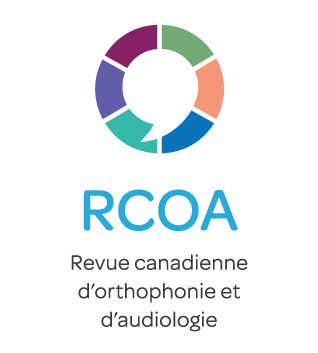

| Auteur(s) |
Caroline Lebel, MOA Michel Picard, B. Ps, PhD |
| Volume | 19 |
| Numéro | 3 |
| Année | 1995 |
| Page(s) | 165-175 |
| Langue | Français |
| Catégorie | |
| Mots-clés |
speech recognition threshold audiometry |
| Abrégé | The Speech Recognition Threshold (SRT) test, designed as a picture identification task, was developed for French-speaking children of Quebec. The instrument was intended for children as young as 5 years of age. First, a list of 25 potential test words was drawn from an examination of 16 selected vocabulary books for French-speaking children. The potential test words were selected from familiar lexical categories such as: body parts, clothing articles, toys, food and vegetables, transportation vehicles and time and waether markers. Each potential word had to lend itself to pictorial representation. An auditory-word recognition test consisting of all 25 potential words was administered to a group of 24 choldren between 4.5 and 5.5 years of age. All the subjects had normal-hearing sensitvity. Two criteria were used to assess the homogeneity of the test material: the potential test words had to be repeated correctly when presented at a +10 dB signal to speech spectrum noise ratio; each child had to correctly name the pictorial representation used for each of the potential test words. Eighteen test items met those two criteria and were retained as test words. They were randomly assinged to onw of tow test lists. Each test list was completed by a set of 36 pictures presented in a close-set response format. The additional pictorial representations were included to control for chance level speech recognition The final test form was administered to 12 children between 4.5 and 5.6 years of age. All the subjects had normal hearing-hearing thresholds. The result produced a gorup performance intensity function that was comparable to that reported for adult listeners. The standard error of estimate was 5.2dB positioning the SRT 80% of the subjects (10-90e percentile) within +/- 6.6 dB of their average pure-tone thresholds at .5, 1 and 2 kHz. Those data were interpreted as a display of both concurrent and predictive validity for the target population. Also, the result revealed that, on average, the SRT's were 3.52 dB less sensitive than the average pure-tone thresholds. This result was different from the performances observed among French-speaking adult subjects and it indicates that children use lexical decision strategies less consistently than adults. |
| ID | 211 |
| Lien | https://cjslpa.ca/files/1995_JSLPA_Vol_19/No_03_141-212/Lebel_Picard_JSLPA_1995.pdf |
La RCOA est une revue en accès libre, ce qui signifie que tous les articles sont disponibles sur Internet dès leur publication, et ce, pour tous les utilisateurs. Les utilisateurs sont autorisés à lire, télécharger, copier, distribuer, imprimer, rechercher ou fournir le lien vers le contenu intégral des articles, ou encore, à utiliser les articles à toutes autres fins légales.
La RCOA ne charge aucun frais pour le traitement ou la publication des manuscrits.
C’est l’Orthophonie et Audiologie Canada (OAC) qui détient les droits d’auteur de la Revue canadienne d’orthophonie et d’audiologie. Il faut mentionner la source (OAC, nom de la publication, titre de l’article, numéro du volume, numéro de la parution et numéro des pages), mais sans laisser entendre que OAC vous approuve ou approuve l’utilisation que vous faites du texte. Il est interdit d’utiliser les documents à des fins commerciales. Il est interdit de modifier, transformer ou développer le texte.